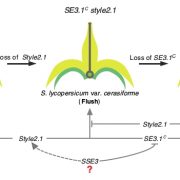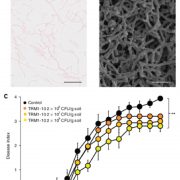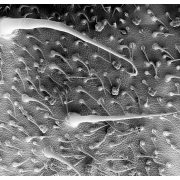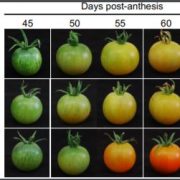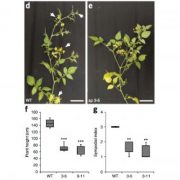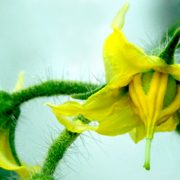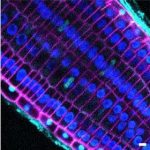MED25 Mediates Shade-Induced Hypocotyl Elongation in Tomato
Author: Sjon Hartman
ORCID: 0000-0002-6709-6436
Plant Ecophysiology, Institute of Environmental Biology, Utrecht University, Padualaan 8, 3584 CH, Utrecht, The Netherlands
Avoiding the shade of neighboring plants is essential to optimize light capture and fuel photosynthesis. Shade avoidance is typically sensed through changes in light quality, is mediated by the activity of phytochromes and modulates other plant stress responses (Courbier and Pierik, 2019). The inactivation of phytochrome B by shade allows Phytochrome Interacting Factor (PIF) transcription factors to bind to (auxin-related) target genes and promote shoot elongation responses. While the molecular mechanisms of shade avoidance and PIF regulation are well understood in the model plant species Arabidopsis (Arabidopsis thaliana), whether PIFs play a similar role in crop species remains elusive. In addition, it is unknown how the cell’s transcription machinery recruits PIFs to control expression of target genes.
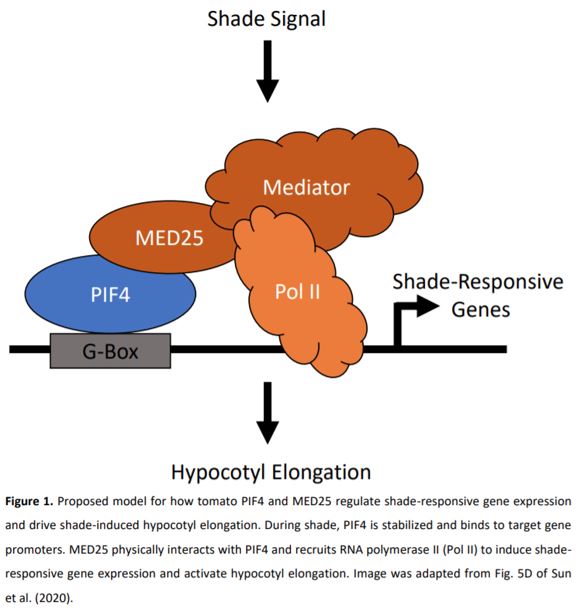 Next, the author searched for potential coactivators of PIF4 in mediating transcriptional activation of its target genes. Previous research identified Mediator Complex Subunit25 (MED25) as an essential regulator of shade avoidance in Arabidopsis (Cerdán and Chory, 2003), but the underlying mechanism remained unknown. Interestingly, the Mediator complex is known to anchor transcription factors with the RNA polymerase II (Pol II) machinery to control target gene transcription under a variety of environmental signals (Elfving et al., 2011; Mathur et al., 2011). Therefore, to test if MED25 coactivates PIF4-mediated transcriptional activation in tomato, the authors tested the binding capacity of PIF4 and MED25 and found that they interact both in vitro and in vivo. In addition, they could show that MED25 recruits Pol II to the promoters of PIF4 target genes. Next, Sun et al. (2020) examined whether MED25 is required for shade-induced hypocotyl elongation and transcriptional responses in tomato seedlings. They found that plants impaired in MED25 levels display a reduction in shade-induced hypocotyl elongation. Accordingly, and similar to pif4 mutants, MED25 antisense lines were also limited in transcriptional activation of PIF4 target genes. Finally, using a transcriptomics approach, the authors show that PIF4 and MED25 co-regulate the expression of a large number of shade-responsive genes. Collectively, the results of Sun et al. (2020) identify MED25 and PIF4 as important transcriptional co-regulators of shade avoidance responses in tomato (Fig. 1).
Next, the author searched for potential coactivators of PIF4 in mediating transcriptional activation of its target genes. Previous research identified Mediator Complex Subunit25 (MED25) as an essential regulator of shade avoidance in Arabidopsis (Cerdán and Chory, 2003), but the underlying mechanism remained unknown. Interestingly, the Mediator complex is known to anchor transcription factors with the RNA polymerase II (Pol II) machinery to control target gene transcription under a variety of environmental signals (Elfving et al., 2011; Mathur et al., 2011). Therefore, to test if MED25 coactivates PIF4-mediated transcriptional activation in tomato, the authors tested the binding capacity of PIF4 and MED25 and found that they interact both in vitro and in vivo. In addition, they could show that MED25 recruits Pol II to the promoters of PIF4 target genes. Next, Sun et al. (2020) examined whether MED25 is required for shade-induced hypocotyl elongation and transcriptional responses in tomato seedlings. They found that plants impaired in MED25 levels display a reduction in shade-induced hypocotyl elongation. Accordingly, and similar to pif4 mutants, MED25 antisense lines were also limited in transcriptional activation of PIF4 target genes. Finally, using a transcriptomics approach, the authors show that PIF4 and MED25 co-regulate the expression of a large number of shade-responsive genes. Collectively, the results of Sun et al. (2020) identify MED25 and PIF4 as important transcriptional co-regulators of shade avoidance responses in tomato (Fig. 1).
Research over the years has identified MED25 as an important transcriptional co-regulator of multiple plant responses that include: ethylene signaling (Yang et al., 2014), shade-induced flowering (Cerdán and Chory, 2003), and jasmonic acid (JA)-mediated defense signaling (Chen et al., 2012). The current work of Sun et al. (2020) adds shade-induced hypocotyl elongation, through the anchoring of PIF4, to the set of responses controlled by MED25. These reports beg the question whether MED25 is a universal transcriptional regulator or whether it can function to balance MED25-controlled transcriptional responses in a multi-stress situation. For instance, recent research in tomato has shown that shade cues reduce the sensitivity to JA-dependent transcriptional responses when attacked by the necrotrophic pathogen Botrytis cinerea (Courbier et al., 2020). MED25 is well known to co-regulate JA responses through recruitment of the MYC2 transcription factor to its target genes (Chen et al., 2012). Does MED25 contribute to the negative crosstalk between shade and JA responses, potentially through direct-binding competition with its respective transcription factors PIF4 and MYC2? In addition, it is likely that MED25-controlled responses achieve higher transcriptional specificity through interaction with other Mediator subunits, such as MED16 (Yang et al., 2014).
While the work of Sun et al. (2020) shows that MED25 and PIF4 control shade-induced hypocotyl elongation in tomato, it remains to be investigated to which extent they also control other shade-mediated responses such as petiole/stem elongation and tomato fruit set (Ji et al., 2019). Such understanding of the regulation of shade responses in crops is crucial to optimally grow our crops in dense vegetations to maximize yield, but limit its adverse consequences in the future.
Literature Cited
Cerdán PD, Chory J (2003) Regulation of flowering time by light quality. Nature 423: 881–885
Chen R, Jiang H, Li L, Zhai Q, Qi L, Zhou W, Liu X, Li H, Zheng W, Sun J, et al (2012) The arabidopsis Mediator subunit MED25 differentially regulates jasmonate and abscisic acid signaling through interacting with the MYC2 and ABI5 transcription factors. Plant Cell 24: 2898–2916
Courbier S, Grevink S, Sluijs E, Bonhomme PO, Kajala K, Van Wees SCM, Pierik R (2020) Far-red light promotes Botrytis cinerea disease development in tomato leaves via jasmonate-dependent modulation of soluble sugars. Plant Cell Environ 1–13
Courbier S, Pierik R (2019) Canopy Light Quality Modulates Stress Responses in Plants. iScience 22: 441–452
Elfving N, Davoine C, Benlloch R, Blomberg J, Brännström K, Müller D, Nilsson A, Ulfstedt M, Ronne H, Wingsle G, et al (2011) The Arabidopsis thaliana Med25 mediator subunit integrates environmental cues to control plant development. Proc Natl Acad Sci U S A 108: 8245–8250
Ji Y, Ouzounis T, Courbier S, Kaiser E, Nguyen PT, Schouten HJ, Visser RGF, Pierik R, Marcelis LFM, Heuvelink E (2019) Far-red radiation increases dry mass partitioning to fruits but reduces Botrytis cinerea resistance in tomato. Environ Exp Bot 168: 103889
Mathur S, Vyas S, Kapoor S, Tyagi AK (2011) The mediator complex in plants: Structure, phylogeny, and expression profiling of representative genes in a dicot (Arabidopsis) and a monocot (Rice) during reproduction and abiotic stress. Plant Physiol 157: 1609–1627
Sun W, Han H, Deng L, Sun C, Xu Y, Lin L, Ren P, Zhao J, Zhai Q, Li C (2020) Mediator Subunit MED25 Physically Interacts with PHYTOCHROME INTERACTING FACTOR 4PIF4 to Regulate Shade-induced Hypocotyl Elongation in Tomato. Plant Physiol pp.00587.2020 https://doi.org/10.1104/pp.20.00587
Yang Y, Ou B, Zhang J, Si W, Gu H, Qin G, Qu LJ (2014) The Arabidopsis Mediator subunit MED16 regulates iron homeostasis by associating with EIN3/EIL1 through subunit MED25. Plant J 77: 838–851


